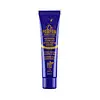What's inside
What's inside
 Key Ingredients
Key Ingredients

 Benefits
Benefits

 Concerns
Concerns

 Ingredients Side-by-side
Ingredients Side-by-side

Hydrogenated Polyisobutene
EmollientCarthamus Tinctorius Seed Oil
MaskingWater
Skin ConditioningButyrospermum Parkii Butter
Skin ConditioningDiisostearyl Malate
EmollientBis-Behenyl/Isostearyl/Phytosteryl Dimer Dilinoleyl Dimer Dilinoleate
EmollientTribehenin
EmollientHydrogenated Palm Kernel Glycerides
EmollientEthylhexyl Palmitate
EmollientEuphorbia Cerifera Wax
Pentylene Glycol
Skin ConditioningOlea Europaea Fruit Oil
MaskingTridecyl Trimellitate
EmollientHydrogenated Vegetable Oil
EmollientMelatonin
AntioxidantSodium Hyaluronate
HumectantLavandula Angustifolia Oil
MaskingChamomilla Recutita Flower Extract
MaskingEuterpe Oleracea Fruit Extract
Lycium Barbarum Fruit Extract
AstringentRubus Villosus Fruit Extract
AstringentVaccinium Angustifolium Fruit Extract
Skin ProtectingCamelina Sativa Seed Oil
Skin ConditioningAlbizia Julibrissin Bark Extract
MaskingOryza Sativa Bran Extract
Skin ConditioningHelianthus Annuus Extract
EmollientRosmarinus Officinalis Leaf Extract
AntimicrobialIpomoea Batatas Root Extract
Skin ConditioningOpuntia Ficus-Indica Stem Extract
Skin ConditioningHydrogenated Palm Glycerides
EmollientGluconolactone
Skin ConditioningGlycerin
HumectantTocopherol
AntioxidantSorbitan Oleate
EmulsifyingButylene Glycol
HumectantIsostearyl Alcohol
EmollientMalic Acid
BufferingCitric Acid
BufferingSodium Benzoate
MaskingPhenoxyethanol
PreservativeHydrogenated Polyisobutene, Carthamus Tinctorius Seed Oil, Water, Butyrospermum Parkii Butter, Diisostearyl Malate, Bis-Behenyl/Isostearyl/Phytosteryl Dimer Dilinoleyl Dimer Dilinoleate, Tribehenin, Hydrogenated Palm Kernel Glycerides, Ethylhexyl Palmitate, Euphorbia Cerifera Wax, Pentylene Glycol, Olea Europaea Fruit Oil, Tridecyl Trimellitate, Hydrogenated Vegetable Oil, Melatonin, Sodium Hyaluronate, Lavandula Angustifolia Oil, Chamomilla Recutita Flower Extract, Euterpe Oleracea Fruit Extract, Lycium Barbarum Fruit Extract, Rubus Villosus Fruit Extract, Vaccinium Angustifolium Fruit Extract, Camelina Sativa Seed Oil, Albizia Julibrissin Bark Extract, Oryza Sativa Bran Extract, Helianthus Annuus Extract, Rosmarinus Officinalis Leaf Extract, Ipomoea Batatas Root Extract, Opuntia Ficus-Indica Stem Extract, Hydrogenated Palm Glycerides, Gluconolactone, Glycerin, Tocopherol, Sorbitan Oleate, Butylene Glycol, Isostearyl Alcohol, Malic Acid, Citric Acid, Sodium Benzoate, Phenoxyethanol
Ricinus Communis Seed Oil
MaskingHydroxystearic Acid
CleansingHelianthus Annuus Seed Oil
EmollientEuphorbia Cerifera Wax
Olea Europaea Fruit Oil
MaskingRicinus Communis Seed Oil, Hydroxystearic Acid, Helianthus Annuus Seed Oil, Euphorbia Cerifera Wax, Olea Europaea Fruit Oil, Ethylhexyl Palmitate, Carica Papaya Fruit Extract, Tribehenin, Aloe Barbadensis Leaf Extract, Sorbitan Isostearate, Rosmarinus Officinalis Leaf Extract, Palmitoyl Tripeptide-8
 Reviews
Reviews

Alternatives
Ingredients Explained
These ingredients are found in both products.
Ingredients higher up in an ingredient list are typically present in a larger amount.
Ethylhexyl Palmitate, also known as octyl palmitate, is created from 2-ethylhexyl alcohol and palmitic acid. It is a fatty acid ester.
The fatty acid content of Ethylhexyl Palmitate makes it an emollient. Emollients help soften and hydrate your skin by trapping moisture within.
Ethylhexyl Palmitate is also used to help improve the texture of cosmetics. It helps other ingredient dissolve in products and help disperse ingredients more evenly.
You'll likely find this ingredient in sunscreen, as it is often used to mix UV-blocking ingredients such as avobenzone and ethylhexyl triazone.
It can also help stabilize the fragrances in a product as a fragrance fixative.
Ethylhexyl Palmitate can be used to substitute mineral oil.
Due to its high fatty acid content, it may not be fungal-acne safe.
Learn more about Ethylhexyl PalmitateOlea Europaea Fruit Oil is the fixed oil obtained from the ripe fruit of the Olive. In other words - olive oil.
The primary contents of olive oil are glycerides of the fatty acids linoleic, oleic and palmitic.
Olive oil also contains antioxidants such as Vitamin E. Antioxidants may help reduce signs of aging by fighting unstable free-radical molecules. It also contains Vitamins A (retinol), D, and K.
The squalene in olive oil makes it a great emollient. Emollients help soothe and soften your skin by trapping moisture in. This makes olive oil a great skin moisturizer.
Studies show olive oil to have antibacterial and antifungal properties in low concentrations. Another study found olive oil irritated sensitive oily skin. We always recommend speaking with a professional about using this ingredient in your routine.
Due to the fatty acid content, this ingredient may not be fungal-acne safe.
Learn more about Olea Europaea Fruit OilRosmarinus Officinalis Leaf Extract comes from rosemary. Rosemary is native to the Mediterranean.
While Rosmarinus Officinalis Leaf Oil can be volatile due to its fragrant properties, the fragrance components are usually removed in the leaf extract.
Rosemary Leaf Extract contains many antioxidants such as rosmarinic acid and caffeic acid. Rosemarinic acid, a compound found in rosemary leaf, has been found to help soothe skin conditions such as eczema and acne.
Learn more about Rosmarinus Officinalis Leaf ExtractTribehenin comes from glycerin and behenic acid.
It is used as an emollient, or moisturizer. Emollients form a thin barrier on skin to prevent moisture from escaping.
This ingredient may not be Malassezia folliculitis, or fungal-acne safe.
Learn more about TribeheninEuphorbia Cerifera wax comes from a shrub in Northern Mexico. It is used to stabilize formulations and has emollient properties.
Emollients form a thin layer on top of skin to prevent water from evaporating, keeping skin and lips hydrated.
According to a manufacturer, this wax can range from a yellow/brown color to translucent.
Learn more about Euphorbia Cerifera Wax